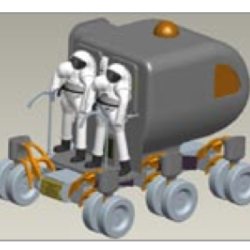Source Institutions
Source Institutions
Add to list Go to activity
Activity link broken? See if it's at the internet archive

In this activity, learners are introduced to challenges of maintaining temperatures while living in space. Thinking and acting like scientists and engineers, learners experiment to learn how to measure the specific heat capacity (or simply, specific heat) of water and then design an improved cooling system like those used in spacesuits. This lesson is developed using a 5E model of learning. In the ENGAGE section of the lesson, learners look at NASA technology and its relationship to improvements in athletic clothing and equipment. They learn about technology in spacesuit design and the use of this technology in everyday life. Working in teams, students conduct experiments relating to specific heat capacity on a cooling system they design in the EXPLORE and EXPLAIN sections. They are challenged to improve the cooling system in the EXTEND section of this lesson. Learners assess their understanding and abilities throughout the lesson and revisit the Essential Questions during the EVALUATE section.
- 45 to 60 minutes
- 1 to 7 days
- $5 - $10 per group of students
- Ages 14 - 18
- Activity, Experiment/Lab Activity, Lesson/Lesson Plan
- English
Quick Guide
Materials List (per group of students)
- computers for research
- two 1-pound or standard size coffee cans with plastic lids
- 4 meters of aquarium tubing
- two buckets
- two long red liquid or digital laboratory thermometers
- duct tape
- ice
- water
- heat lamp (≥100 watts)
- single-hole punch
- large nail and hammer
- Student Handouts
- digital camera (optional)
- graphing calculators (optional)
- temperature probes (optional)
- drill or metal punch (optional)
Subjects
- Earth and Space Science
-
Engineering and Technology
-
Engineering
- Aerospace Engineering
- Technology
-
Engineering
-
Mathematics
- Algebra
-
Data Analysis and Probability
- Data Analysis
- Data Collection
- Measurement
-
The Nature of Technology
-
Technology and Society
- Impacts of Technology
-
The Design Process
- Research and Development
- Invention and Innovation
- Troubleshooting and Maintenance
-
Technology and Society
-
Physical Sciences
-
Heat and Thermodynamics
- Heat and Temperature
- Heat Transfer
- Energy
- States of Matter
-
Structure and Properties of Matter
- Mass and Weight
- Volume and Density
-
Heat and Thermodynamics
-
The Nature of Science
-
The Scientific Process
- Asking Questions
- Conducting Investigations
- Gathering Data
- Formulating Explanations
- Communicating Results
- Science as a Career
-
The Scientific Process
Audience
To use this activity, learners need to:
- see
- read
- touch
Learning styles supported:
- Involves teamwork and communication skills
- Involves hands-on or lab activities
Other
Components that are part of this resource:
- NASA Spinoff Page
- What Can I Wear Today? article
- Spacesuits and How They Work video
- NASA article, NASA “Spacesuits” Help Brothers With Rare Genetic Defect
- NASA eClips video segment, The Making of the Biosuit
- NASA eClips video segment, Protective Materials for Spacecraft
- NASA multimedia gallery, Evolution of the NASA Spacesuit
Includes alignment to state and/or national standards:
Includes assesments for student learning:
This resource is part of:
Access Rights:
- Free access
By:
Rights:
- Public domain, NASA,
